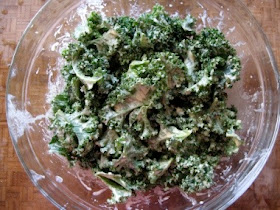I'm seeing the kitchen differently since we've been eating mostly raw, living food. Today I noticed that I've begun to put vegetables in water, like flowers, until they are used. We eat so many vegetables it's not long before they are used, but treating the vegetables like precious roses makes a significant difference to both how they look and their flavour. Being refrigerated seems to make them go to sleep. Cutting their stems so they can accept the water they are standing in brings the life back to them.

Washing salad greens, spinning them in the salad spinner, then letting them sit there with the water from spinning beneath the basket of the spinner with the lid on for a little while, gives the lettuce a fresh picked perkiness.
I've recently found a recipe for "spinach crowns" (although I call them spinach hearts) which uses the bottom part of the spinach normally thrown away. They don't look like much when first separated from the leaves, but once cleaned , I wash them and put them in a bowl with a tiny bit of water at the bottom. A damp cloth goes over top. They spring to life in a few hours and look beautiful on the plate. Not convinced? I'll post the recipe soon.
This is the damp environment to wake up the spinach hearts. They open beautifully under cover.

See?

There is a different pace to a raw kitchen. Because so much attention is paid to waking the living spirit of food, a lot of grains and nuts and seeds are soaked. Some are then also sprouted before using. Grains might be soaked, sprouted, ground, dehydrated and finally used as flour. Why soak?
Seeds, nuts and grains want to protect themselves from sprouting at inappropriate times or rotting so they have enzyme inhibitors called phytates in them. Soaking removes the phytates and wakes up the plant in the grain, nut or seed. This also makes its nutrients more bio-available to us. One needs to think in the Long Now to begin the process of soaking or sprouting ahead of time.
One also needs a soaking and sprouting station in the kitchen. When I first began I had bowls of soaking grains, seeds and nuts in random places on the kitchen counter. It was chaos. A simple tiered shelf meant to go in a cupboard gave me the soaking station I needed. Of course, one could also use a cupboard but I know if I did that I'd forget about whatever was in the containers. These containers have lids but they are not airtight. Air is essential for waking up. I also use this station for culturing nut cheeses once they have soaked.

I was lucky to find a large Ball jar with a sprouting lid (allows water in and out but does not allow contents to escape).

While I am sprouting grains or seeds in it, I keep it in a draining rack, but covered from daylight with a cloth. (You are probably wondering what those doily things are. I'll get to that in a minute.)

After an initial over night soaking, the spouts need to be rinsed two or three times a day, depending on the temperature. Maybe it's just that I am amused by small things, but I enjoy that I can fill the jar with water without taking the lid off and that it's so easy to lean the jar in the drying rack and watch the water come out the spout. A drying rack with a spout? Like I said...small things.....

Oh, and the things that look like doilies? Well, practically, they tell me that something in side is processing, becoming more alive, and may need my attention. On a higher level, it connects with the work of Masaru Emoto. Maybe I'll explain that more in another post.
So, as fire and ice are central to a regular kitchen (stove and refrigerator), water and wind (high speed blender and dehydrator) are essential to a raw kitchen. Time is entirely different in a raw kitchen. Dishes are made on nature's time. "Cooking" is done by sprouting or slowly drying. It almost feels like I use a different part of my brain to prepare food this way.
I'd like to design a raw kitchen from scratch. Even to SEE one! I'd like that for a start.





















































